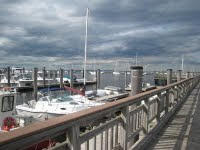The final solution of the Green Marina should fit the design brief and follow all specifications and limitations set for the project. An environmentally friendly marina should be produced on the site where the Atlantic Highlands Marina currently exists. Rather than testing out the actual model itself, which would be pointless, the concept will be tested. The most logical way to test out the design is to ask an expert involved with green marinas to come evaluate the final solution and final product.
Exploratory tests: The exploratory test for this project can take place throughout the brainstorming process. The designs should all be thought through and basic design questions should be thought through. The marina layouts should all be logical and have working designs.
Assessment tests: Once a final solution has been chosen, assessment tests should take place to decide if the final chosen solution is a viable one. Design matrices can be used to help conduct assessment tests.
Validation tests: The final marina solution should go through validation tests in order to make sure the design fulfills the design brief and adheres to all of the specifications and limitations listed for the project. The chosen solution should also match up to the partner's solution.
Comparison tests: Comparison tests can be conducted at the completion of the Green Marina project. Having an expert in green marinas evaluate our designs and compare them to current and effective green marinas can complete the comparison tests. Creating a survey for a specialist in green marinas to fill out will help them grade the effectiveness of the design easier.
Testing Procedures:A structural engineer will be called in to review
BT (myself) and
JB's portions of the project, because we are both structural engineers and developed two separate solutions to fit with
KK's solution for the land. The structural engineer would review the effectiveness of the docking system along with how structurally safe/effective the docks themselves are. They would review everything in the marina design from the waterline out. An environmental specialist or engineer could be called in to review how environmentally safe and friendly the design is. They would look at things such as how power is generated, where waste is disposed of, where runoff water goes, and many other details involved with the marina.
1. Set up a meeting with a specialist who is familiar with green marinas. For example, Mr.
Danko could be used to review the final project.
2. Have a checklist or survey prepared for the specialist so that they can review the list and know what criteria they need to grade the design off of. Make sure to list the specifications of the project on the survey, so they know what needed to be accomplished with this project.
3. Give the specialist a presentation on the project as a whole. Tell them the overview of the project, and include the design brief, specifications, and limitations. Also include an overview of the design process, selection/rejection, and how you developed the design to make it the final solution it is in the end.
4. Using the model built and any drawings made, explain the marina design and how it works. Make sure to include the various parts of the marina that make it environmentally friendly and "green." Explain traffic flow, how the docks are structured, materials, etc. Thoroughly explain every part of the design.
5. Ask if the specialist has any questions concerning the design or how it works. Make sure they completely understand the the project, as well as your solution.
6. Give the specialist the prepared survey/checklist so they can review and critique the design. Leave room for them to comment about what they think about the project and how you did as a whole, or for any comments they feel like leaving.
7. The marina design should be graded for how effectively it works and functions as a marina, as well as how environmentally friendly it is.
8. Compare the two final solutions for the structural portion of the project to see which is more environmentally friendly.
Survey:The purpose of this survey is to review and comment on the structural engineering portion of the Green Marina Project.
Is the marina constructed from environmentally friendly materials?
Are there prevention methods taken in areas where there is a high amount of pollution?
Do the docks fit an appropriate amount of boats?
Do the docks accommodate different sized boats?
Is the boat traffic pattern of the marina logical?
Are all necessary parts of a marina included in the design?
Does the design follow all New Jersey rules and regulations concerning marinas?
How effective is the solution for the issue of erosion?
How effective is the solution for the issue of
petroleum leakage?
What aspects of the marina are the most logical? Which parts of the marina do not make sense/need improvement?
How is the marina protected from the bay? How effective is that means of protection?
Rate the marina on how environmentally friendly it is on a scale of 1 to 10, and explain reasoning:
Does the model accurately depict the marina design?
Do the drawings accurately depict the marina design?




